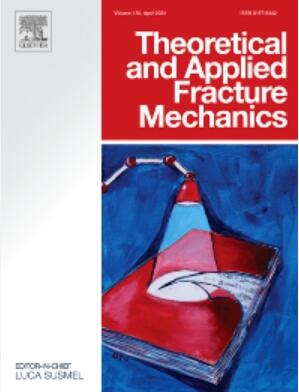Study on fracture characteristics of 3D-ILC brittle solids under high-temperature loading in three-point bending
IF 5
2区 工程技术
Q1 ENGINEERING, MECHANICAL
引用次数: 0
Abstract
This study predicts the mechanical behavior and crack propagation of rock-like materials under high-temperature conditions in deep engineering applications through experimental and numerical simulations. The 3D-ILC method was utilized to induce three-dimensional fissures in a semi-circular disk specimen. The three-point bending test following high-temperature cooling was conducted to analyze the failure mode and fracture morphology. By integrating the maximum tensile stress criterion, M−integral method, and finite element analysis, a thermomechanical simulation of three-dimensional crack propagation is conducted. This reveals the relationship between the stress intensity factor at the crack tip and the relative circumference of the crack front, enabling a detailed visualization of the crack propagation path. The results show that the horizontal single crack extends in a “U”-shaped pattern with increasing temperature, while dynamic fracture occurs along the crack center during the three-point bending test. At high temperatures, crack propagation in the specimens is primarily governed by Mode I, whereas in the three-point bending tests, crack propagation transitions through Modes I, II, and III. This study provides a robust framework for analyzing the mechanical behavior of rock-like materials under thermal and mechanical loading in deep engineering environments.
三维-ILC 脆性固体在三点弯曲高温加载下的断裂特性研究
本研究通过实验和数值模拟,预测了深层工程应用中类岩石材料在高温条件下的力学行为和裂纹扩展。利用 3D-ILC 方法在半圆形圆盘试样中诱导三维裂缝。对高温冷却后的三点弯曲试验进行了失效模式和断口形态分析。通过整合最大拉伸应力准则、M积分法和有限元分析,对三维裂纹扩展进行了热力学模拟。这揭示了裂纹尖端的应力强度因子与裂纹前沿相对周长之间的关系,使裂纹扩展路径的详细可视化成为可能。结果表明,随着温度的升高,水平单裂纹呈 "U "形扩展,而在三点弯曲试验中,沿裂纹中心发生动态断裂。在高温条件下,试样中的裂纹扩展主要受模式 I 的支配,而在三点弯曲试验中,裂纹扩展则通过模式 I、II 和 III 发生转变。这项研究为分析深层工程环境中热负荷和机械负荷下岩状材料的力学行为提供了一个稳健的框架。
本文章由计算机程序翻译,如有差异,请以英文原文为准。
求助全文
约1分钟内获得全文
求助全文
来源期刊

Theoretical and Applied Fracture Mechanics
工程技术-工程:机械
CiteScore
8.40
自引率
18.90%
发文量
435
审稿时长
37 days
期刊介绍:
Theoretical and Applied Fracture Mechanics'' aims & scopes have been re-designed to cover both the theoretical, applied, and numerical aspects associated with those cracking related phenomena taking place, at a micro-, meso-, and macroscopic level, in materials/components/structures of any kind.
The journal aims to cover the cracking/mechanical behaviour of materials/components/structures in those situations involving both time-independent and time-dependent system of external forces/moments (such as, for instance, quasi-static, impulsive, impact, blasting, creep, contact, and fatigue loading). Since, under the above circumstances, the mechanical behaviour of cracked materials/components/structures is also affected by the environmental conditions, the journal would consider also those theoretical/experimental research works investigating the effect of external variables such as, for instance, the effect of corrosive environments as well as of high/low-temperature.
 求助内容:
求助内容: 应助结果提醒方式:
应助结果提醒方式:


